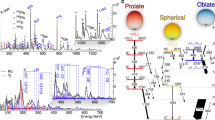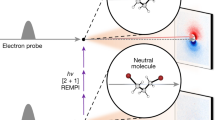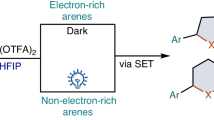Abstract
IT is known that the predissociation produced by the radiationless transition from an excited stable molecular state to an unstable one is responsible for the broadening of the absorption rotational lines and the increase in intensity of the perturbed bands. In the emission spectrum, the bands vanish in the region of perturbation. This usual case is well illustrated in the band system B3∑−u – X3∑−g of S2. In the progression v″ = 0, the absorption spectrum shows sharp band heads up to v′ = 9, while the v′ = 10, 11 … bands are very diffuse. At v′ = 10 a strong intensity increase occurs. This predissociation corresponds to the case I(c) of Herzberg1 due to an interaction between two excited states one of which is stable and the other of repulsive type. The crossing of these two potential energy curves occurs above the dissociation limit of the repulsive level. So far it is the only well-established case of this kind.
This is a preview of subscription content, access via your institution
Access options
Subscribe to this journal
Receive 51 print issues and online access
$199.00 per year
only $3.90 per issue
Buy this article
- Purchase on SpringerLink
- Instant access to full article PDF
Prices may be subject to local taxes which are calculated during checkout
Similar content being viewed by others
References
Herzberg, G., Molecular Spectra and Molecular Structure, 1, Spectra of Diatomic Molecules, second ed., 424 (D. Van Nostrand Co., New York, 1950).
Mulliken, R. S., J. Chem. Phys., 33, 247 (1960).
Author information
Authors and Affiliations
Rights and permissions
About this article
Cite this article
HERMAN, L., HERMAN, R. Predissociation and Perturbation in the Selenium Molecule. Nature 199, 795 (1963). https://doi.org/10.1038/199795a0
Issue date:
DOI: https://doi.org/10.1038/199795a0



